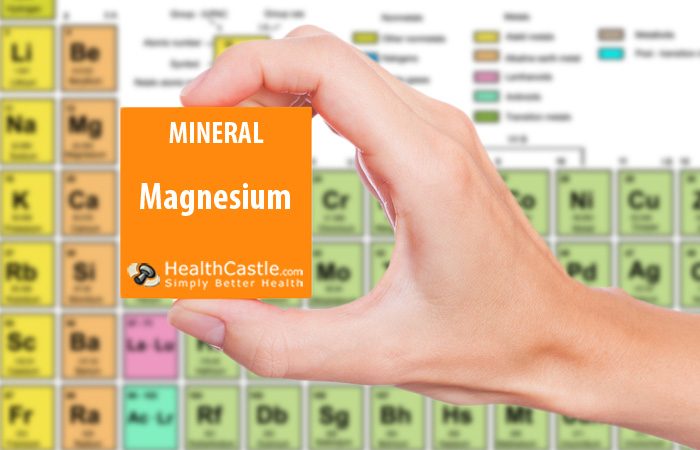
Written By: Carolyn Berry, RD
Title: Registered Dietitian
Alumni: University of British Columbia
Last Updated on:


Magnesium is an abundant mineral in the body and is naturally present in many foods. Magnesium is important in more than 300 chemical reactions that keep the body working properly.
Table of Contents
The Dietary Reference Intakes (DRI) for magnesium are shown below:
| Age Group | Recommended Dietary Allowance (RDA) per Day1 | Tolerable Upper Intake Level (UL) per Day2 |
| Adults | ||
| 19 to 30 years | 400 mg male
310 mg female | 350 mg |
| 31 years and up | 420 mg male
320 mg female | 350 mg |
| Kids and Youth | ||
| 1 to 3 years | 80 mg | 65 mg |
| 4 to 8 years | 130 mg | 110 mg |
| 9 to 13 years | 240 mg | 350 mg |
| 14 to 18 years | 410 mg male
360 mg female | 350 mg |
| Special Considerations | ||
| Pregnant or lactating women 14 to 18 years | 400 mg pregnant
360 mg lactating | 350 mg |
| Pregnant or lactating women 19 to 30 years | 350 mg pregnant
310 mg lactating | 350 mg |
| Pregnant or lactating women 31 years and up | 360 mg pregnant
320 mg lactating | 350 mg |
Note: The Upper Limit for magnesium represent intake from a pharmacological agent only and do not include intake from food and water.
Magnesium plays a large role in creating and maintaining bone integrity. About 50-60% of the magnesium in our bodies is stored in our bone, and the rest in soft tissues. It helps to regulate bone and mineral status3. Specifically, when magnesium intake is very low, levels of parathyroid hormone decrease. This leads to a reduced absorption of calcium in the intestines, as well as increased loss of calcium and magnesium in the urine.
Magnesium is necessary to enable energy production in the body – it works as a critical cofactor for over 300 enzyme systems that regulate diverse biochemical reactions in the body4. These include glucose and fat breakdown; production of proteins, enzymes, and antioxidants; DNA synthesis; regulation of cholesterol production; muscle and nerve function; and blood pressure regulation and blood clotting. A cofactor is a compound required for an enzyme to be active. Magnesium is necessary for the production of ATP, the high-energy molecule that stores and transports chemical energy within cells for metabolism.
Magnesium regulates our electrolyte balance5. A proper mineral content balance must be maintained within every cell in the body. Magnesium’s role in the healthy balance (or “homeostasis”) of important minerals such as calcium, sodium, and potassium affects the conduction of nerve impulses, muscle contraction, and heart rhythms.
Magnesium helps the body to better control inflammation6 by helping prevent and control hypertension, diabetes, and cardiovascular disease. A diet low in magnesium has been linked to unwanted increases in the inflammatory process.
The best sources of magnesium are legumes, nuts, seeds, fish, and whole grains. For the most part, foods with dietary fiber contain magnesium. Some breakfast cereals and other grain products are fortified with magnesium. Some types of food processing, such as refining grains in ways that remove the nutrient-rich germ and bran, lower magnesium content substantially.
Tap, mineral, and bottled waters can also be significant sources of magnesium, depending on the source and brand.
| Food | Magnesium per serving |
| Pumpkin or squash seeds, roasted, 1/4 cup | 317 mg |
| Brazil nuts, without shell, 1/4 cup | 133 mg |
| Cheese, soy, 1-1/2 oz | 114 mg |
| Sunflower seeds, 1/4 cup | 114 mg |
| Cereal, All Bran, 1/2 cup | 112 mg |
| Edamame/soybeans, boiled, 3/4 cup | 111 mg |
| Salmon, Chinook, cooked, 3 oz | 104 mg |
| Cashews, 1/4 cup | 90 mg |
| Tofu, prepared with magnesium chloride or calcium sulfate, 3/4 cup | 45-80 mg |
| Black-eyed peas, cooked, 3/4 cups | 64 mg |
| Sesame seeds, 2 tbsp | 63 mg |
| Quinoa, cooked, 1/2 cup | 59 mg |
| Lentils, cooked, 3/4 cup | 53 mg |
| Swiss chard, raw, 1 cup | 29 mg |
| Halibut, cooked, 3 oz | 28 mg |
| Beet greens, raw, 1 cup | 27 mg |
| Spinach, raw, 1 cup | 24 mg |
In the United States: The Daily Value (DV) for magnesium is 420 mg7 for ages 4 and older, which is equal to the RDA for adult males. The number you see on the Nutrition Facts label is a percentage calculated by dividing the amount of magnesium in one serving of the food by the daily value. For example, 3/4 cups of edamame, which contains 111 mg, has 26% of the daily value (DV) for magnesium. The FDA does not require food labels to list magnesium content unless a food has been fortified with this nutrient. Foods providing 20% or more of the DV are considered to be high sources of a nutrient.
In Canada: The Daily Value for magnesium is 420 mg8, which is equal to the RDA for adult males and females. Using the same example as above, 3/4 cup of edamame has 26% of the daily value for magnesium. Listing the DV for magnesium on the label is optional.
Calcium: Calcium supplements can decrease the absorption of dietary magnesium, but only at very high doses (~2600 mg per day). However, in people with adequate magnesium stores, research has shown that calcium does not have any clinically significant effect on long-term magnesium balance.
Vitamin D: Various forms of Vitamin D may slightly increase magnesium absorption, especially when taken in high doses. Magnesium is also required for all of the enzymes that metabolize Vitamin D.
Zinc: High doses of zinc in supplemental form may interfere with the absorption of magnesium.
HealthCastle has strict sourcing guidelines. We reference peer-reviewed studies, scientific journals and associations. We only use quality, credible sources to ensure content accuracy and integrity.
Alumni: University of British Columbia – Carolyn Berry is a Vancouver-based Registered Dietitian, self-proclaimed foodie, marathon runner, and owner of Berry Nourished. Carolyn works in a variety of areas including clinical nutrition, outpatient counselling at Medisys Preventive Health Clinic, as a nutrition tour leader with Save-On-Foods, and in the media, including segments on CBC Television, CKNW and Spice Radio. Through informative and practical nutrition advice and her food-first approach to health, Carolyn fulfills her passion to empower others with knowledge about nutrition so that they can make the best decisions to improve their health. She strongly believes that food should be both healthful and delicious.
magnesium, micronutrient - minerals, minerals